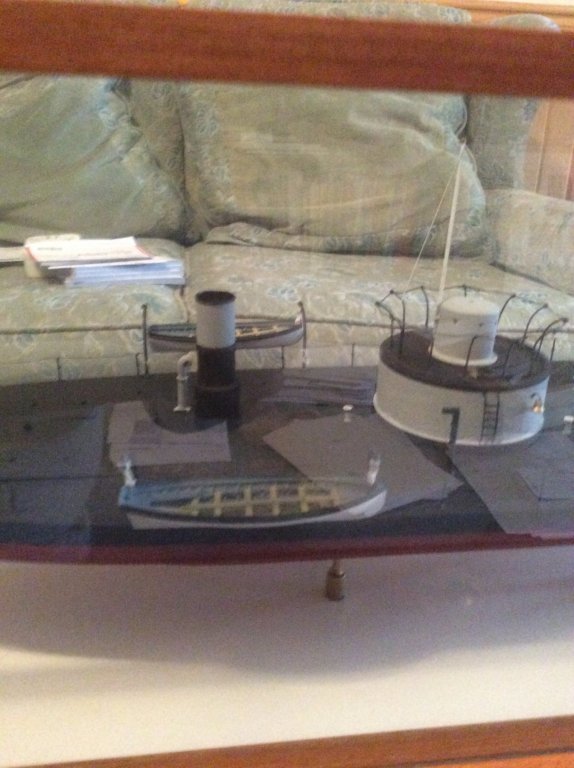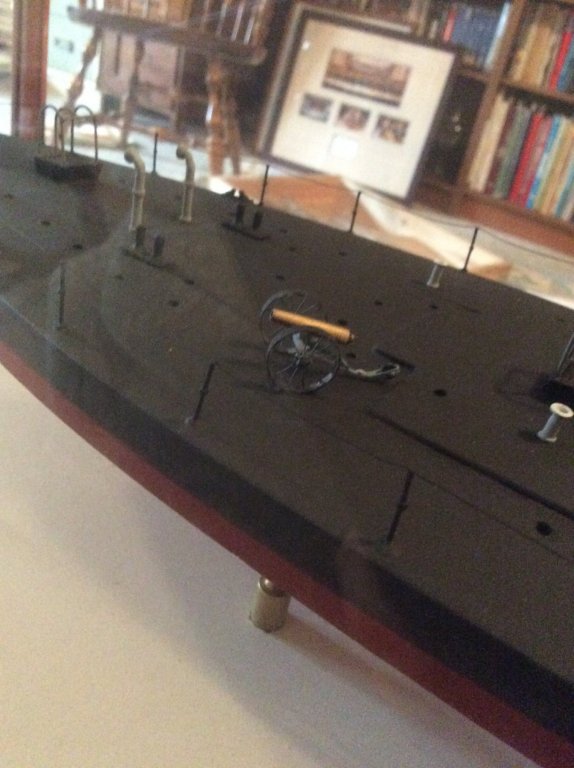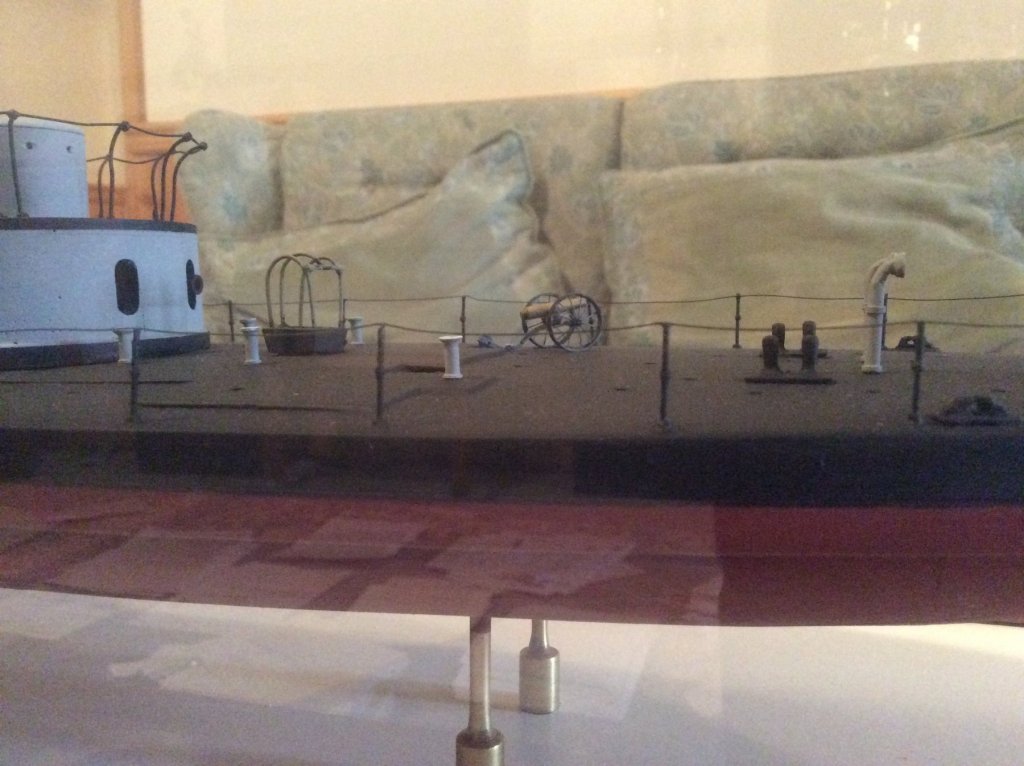
Roger Pellett
-
Posts
4,519 -
Joined
-
Last visited
Content Type
Profiles
Forums
Gallery
Events
Posts posted by Roger Pellett
-
-
I have a copy in excellent condition of Olof A. Eriksen's. Constitution: All Sails Up and Flying for sale. If you are not familiar with the book it is 350+ pages of drawings, photos and text describing in detail the rigging of a large scale (1:24) model of the ship as she appeared in 1815. The book's large, approximately 8in x 10in format allows the author's well made drawings to be shown in great detail.
The list price marked on the book is $122.95 and used copies are selling on Amazon and Alibris in the range of $85 to $90. I am asking $48 plus shipping for the book. As I don't want to deal with international post, customs, and payment my offer is limited to US destinations only.
If you are interested, send me a PM.
Roger
-
Hi Steve,
It's a small world! In 1997 my daughter Rebecca, a senior at the University of Michigan wrote a thesis titled Jane Austin and the Royal Navy. If you google Rebecca Pellett + Jane Austin it is listed on the University's English Department website. The key document that inspired her to write the thesis was a book of her letters that demonstrated that Miss Austin was very involved in her brothers' careers. I think that the book was either Jane Austin's Sailor Brothers by John H. Hubback or Jane Austin's Letters by R.W. Chapman as both are listed in her bibliography.
In addition to the sources listed by others, The Command of the Ocean by N.A.M. Rodger also includes much on your topic. It should be easy to find.
Roger
- Canute, mtaylor and uss frolick
-
 3
3
-
A number of years ago, I read about using potassium permanganate to stain curley maple muzzle loading rifle stocks. I bought some and used it to stain a stock. At first it worked fine but over time it developed an ugly green tint. I don't know if rigging line would be affected the same way.
Roger
-
I have found three examples of models or drawings of rigged Royal Navy longboats from this era:.
Rigged model in the NMM, the "Medway" model. Evidence that it was restored by Norman Ough in the 1930's. Traveler runs below tiller.
Rigged model in the Kreigstein collection. Rigging is not original. Traveler runs below tiller.
Longboat drawing on page 126 of Lavery's Arming and Fitting apparently a redraw of Admiralty draught reproduced on page 90 of May's Boats of Men of War. Rigging is highly detailed and shows traveler running OVER the tiller.
If anyone has found additional examples, I would appreciate knowing the details.
I will concede that someone making a model of a model as a work of art might wish to reproduce the NMM model, but would this would certainly not be a practical sailing arrangement.
Roger
- thibaultron, Cathead and coxswain
-
 3
3
-
If you have your heart set on building a plank on frame model as your first effort, I recommend the Hahn system which provides a datum to align pre fabricated frames. The Ancre method involves cutting out and erecting many separate frame segments on the keel. While the Ancre method more resembles construction of a real ship, Hahn's system is a great introduction to POF modeling.
Hahn was a prolific writer and in addition to publishing two books, many of his articles can be found in the Nautical Research Journal- check the on line index. The NRG is about to republish the first volume of their Shop Notes and this includes an article by Hahn describing his method as well as patterns for building on of his Revolutionary War era schooners.
When Hahn built his models he used an 8in table saw with hollow ground veneer blades, not a miniature saw. I built a POF model of the New York Pilot Boat Anna Marie with good results from Chapelle plans using Hahn's system and 8in table saw.
Hahn's early models were built from maple, not box or pear wood. If you are an experienced modeler, I don't think that you need to buy a kit.
Roger
-
I'm sorry but must disagree with Chuck's comment above. With the main sheet traveler located below the tiller it would be impossible to either tack or gybe the boat. I do have primary source information of a longboat traveler located above the tiller- the Admiralty draught of the rigged longboat shown on page of 90 of W.E. May's Boats of Men of War. I cannot explain the traveler arrangement on the period built rigged models cited, but real boats could not be sailed with this rig.
Roger
- thibaultron and coxswain
-
 2
2
-
-
I agree with Welfalk. The winch in the photo is a Jarvis brace winch. The double drum arrangement allowed the brace on one side to be wound in while the other paid out. There is a good discussion of these winches in John Harland's book Capstans and Windlasses. Closer to home (for you) Allen Villers has written about these from a sailor's point of view. See his The Way of a Ship.
Roger
- popeye the sailor, mtaylor and cog
-
 3
3
-
-
In purchasing the five volume set of books about the archaeology excavations at Red Bay in Canada, I wound up with a duplicate copy of Volume III. For modelers this is the best of the five volumes as it contains complete information about the galleon that was recovered and documented. It includes a reconstructed lines drawing as well as longitudinal and cross sections, isometric assembly drawings and details of many parts. An envelope on the back cover includes a separate large scale fold out drawing.
The book measures approximately 8in x 11 in and is 319 pages long. It includes 100's of photos as well as drawings.
The book is brand new, never read, and the galleon is a perfect subject for an accurate model of the period.
i am willing to trade this for a similar maritime history book. Send me a PM if interested.
Roger
- mtaylor and thibaultron
-
 2
2
-
-
50 years ago the wood of choice of professional model builders carving models for the University of Michigan's ship model towing tank (now called their Marine Hydrodynamics Lab) was "pattern makers pine." This stuff came in beautiful, long, clear, straight grained lengths. The models towed in the tank were large- 8 or so feet long. Today, the models are styrofoam core fiberglass made by outside contractors.
So what is pattern makers pine? One Internet site that I looked at said that Northern White Pine was used for patterns. This is the stuff being recovered from the bottom of Lake Superior near Bayfield WI. Living in Maine and Illinois you should be able to find some at a small mill.
The other possibility would be western Sugar Pine. Our local Menards store has been carrying some nice 5/4 lumber that I believe is sugar pine.
The preferred way to build a large solid hull is from laminations to minimize chances for warping and cracking.
Roger
- Canute, mtaylor and John Allen
-
 3
3
-
-
A number of years ago I bought a set of tiny end mills from my local hobby shop. They were carbide mills sold by Drill Bit City that had been recycled from printed circuit board manufacturers. I tried to use them to mill brass and everyone of them broke. I have not tried to use them since.
i tend to be heavy handed, so perhaps I was too aggressive with them, but these Drill Bit City carbide mills seemed awfully brittle.
Roger
-
Gerhardt/ John, Thanks to each of you for your kind remarks regarding my Passaic Class monitor model. It is interesting to watch two models of USS Cairo being built simultaneously to high standards.
Regarding authentic Civil War ship's boat details. The best photo that I have found that shows a US Navy ship's boat up close is one taken by James Brady of USS Onondaga in the James River in 1864. The photo shows a group of soldiers or marines in what appears to be a small cutter up close with the Onondaga in the background. Google Onondaga and you will find it.
The photo shows the distinctive sheer strake design that I mentioned above, and the brass castings that formed the openings in the wash strake for the oars. If you are ordering photo etched parts you might want to include a supply of these.
Also interesting is the variety of boats moored along side Onondaga.
The Civil War navy museum in Columbus, GA has a Ship's boat from USS Hartford and there is a photo on their website. Hartford, however, had a very long life and photos of many of these Civil War Ship's that survived into the 1900's show them outfitted with standard 1900 pattern boats. Additional research of this boat is in order.
Roger
- Canute, cog, johnhoward and 3 others
-
 6
6
-
Personal Experience!! For working on carved hulls you need to buy a carver's glove or at least a heavy knit glove to protect your hands. Use this to protect the hand that is not holding the tool. One slip with a sharp chisel and you are on your way to the emergency room.
Roger
-
The whole subject of US Navy ships boats supplied to the fleet prior to 1900 is a bit of a black hole. Prior to the late 1890's ships boats were not standardized, being designed by the boat shops at each navy yard. The boats from Chapelle's book were designed at the Washington Navy Yard and those for Jerry Todd's Constellation at the Norfolk Navy Yard. There are boat allowances that at least specify overall dimensions for boats allowed to be carried by different classes. See, for example, William Brady's Kedge Anchor. A 26ft launch is to have a breadth of 7.4ft and a depth of 3.4ft. A 26ft cutter a breadth of 6.6ft and a depth of 2.4ft (this dimension might not include the cutter's wash strake). Complicating this fact is that we don't know where the boats for the river gunboats came from. Were they built at St Louis or were they supplied by one of the Navy yards? Additionally complicating things is the fact that the gunboat fleet was originally controlled by the Army, later transferred to the Navy. Boats were subject to hard usage and were always being knocked about, so the lifetime of an individual boat might have been short.
I thought that you might enjoy photos of a 26ft cutter and a boat howitzer that I built for my 1:96 scale model of the monitor USS Catskills.
-
Cutter/Launch: In British and US Navy usage, a vessel's launch was a heavy workboat equipped with a windlass. It was especially intended for handling anchors. To do this British launches were equipped removable stern davits. American launches of the Civil War were equipped with bow and stern rollers for handling heavy lines but they did not have stern davits. US Navy launches of the period were equipped with a pair of pluggable openings near the windlass for passing lines through the bottom of the boat. When in use, a copper funnel or "trunk" was screwed into the opening. Launches typically were not fitted with wash strakes. The top two hull strakes on Civil War US Navy ships' boats employed a distinctive ship lap planking detail that shows up on period photographs. This detail is described in Theodore Wilson's shipbuilding book. Constellation's launch posted by Jerry Todd shows the characteristics of a typical launch. Such a boat would have been useful on a gunboat operating on shallow river waters, for carrying out heavy hawsers and anchors.
The launch pictured by Chapelle, is not typical and looks more like a cutter. A cutter was a boat designed to be seaworthy enough to be used for boarding vessels at sea. Freeboard was increased by adding a wash strake above the normal hull planking, and lines were usually finer. They would have been useful aboard a gunboat for landing shore expeditions.
Keep in in mind that these are "big" boats. A 26ft launch or even a cutter was a heavy displacement boat that would have required a large crew to row against swift river currents. Perhaps, a launch, two cutters, and a smaller handier boat might have been more practical.
Roger
- Cathead, Gerhardvienna, mtaylor and 1 other
-
 4
4
-
The basis for a worthwhile ship model is an accurate set of hull lines. Unless built to historically documented hull lines, you are really building a freelance model despite the accuracy of the paint scheme, rigging, etc.. See Howard Chapelle's "Ship Models That Should Not Be Built," or L. Francis Herreschoff's writings on model building. The Lake Erie Brigs were a particular problem for Chapelle who in the early 1930's designed the predessor to the current Niagara replica. Chapelle has written that he always had an uneasy feeling that the lines of the replica did not reflect the original vessel. In particular he thought that was the bow lines might be too sharp. The current vessel was a new design by Melbourne Smith. Each of the three Niagara replicas 1913, 1933, and 1988 were built to a different set of principal dimensions.
Chapelle also described model builders as "stubborn cusses" who Insist on building models without sufficient documentation. The Lake Erie battles were exciting events in our nation's history and from a naval architectural standpoint, the problem of designing these shallow draft gun vessels was an interesting one so the lure of building one of these brigs despite the existence of historical documentation is compelling.
Fortunately, an example of a shallow draft gun brig built by the same builders as the original Niagara exists and has been explored - the brig Eagle built to defend Lake Champlain. Builders wishing to build an example of a shallow draft American gun brig designed for lake service during the war of 1812 would be better off choosing the Eagle than Niagara or Lawrence.
Roger
-
In the Crabtree collection at the Mariners Museum at Newport News, there is a model of a cave man polling or paddling a log raft. The guy is wearing an animal hide garment that according to the museum is a tanned mouse skin.
Roger
- PETERPETER, EdT, AON and 3 others
-
 6
6
-
Are you sure that the capstan was steam driven? With large navy crews could the capstan have been manned by hand. We're steam driven Capstans used on the rivers in the 1860's?
The Smaller caliber Dhalgren boat howitzers were designed to arm boats (especially launches) in support of amphibious operations, a requirement stemming from the earlier Mexican War where the navy was required to land troops and lacked an effective light weight artillery piece. The idea was to mount the gun in the bow to be able to fire it while approaching the shore and to then quickly dismount it and to remount it on the field carriage that had been carried separately in the boat's stern sheets. The field carriage was to be wheeled ashore over a ramp formed by extending timbers from the boat's bow. The "sledge" that you refer to is the mounting for use in arming the boat. Most photos show these boat howitzers on iron field carriages when aboard ship. My Dixie Gun Works materials which are copies of the original drawings apply to the light 12 pound howitzer and depict a "hybred" field carriage- iron and bronze except the two main wheels which are wooden. The small tail wheel is iron.
The best reference that I can recommend that covers Civil War naval artillery is "Arming the Fleet" by Spencer Tucker. You can also download a copy of a Civil War US Navy Ordinance Manual on line from google books.
Roger
- Gerhardvienna, Canute and mtaylor
-
 3
3
-
Dixie Gun Works, in Union City, Tennessee sells monographs of US Civil War artillery. They have one on the Dhalgren light 12 pounder boat howitzer and its field carriage. You could literally build one from this monograph. Look them up on the web.
Roger
- Gerhardvienna, Canute and mtaylor
-
 3
3
-
-




USS Constitution Builders
in Traders, Dealers, Buying or Selling anything? - Discuss New Products and Ship Model Goodies here as well!!
Posted
The Constitution book has been sold.
Roger